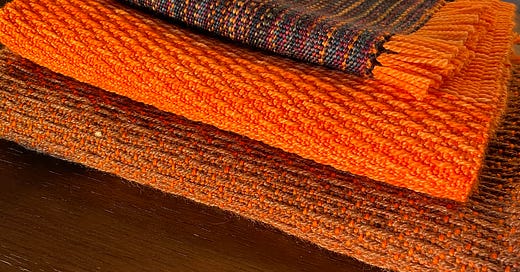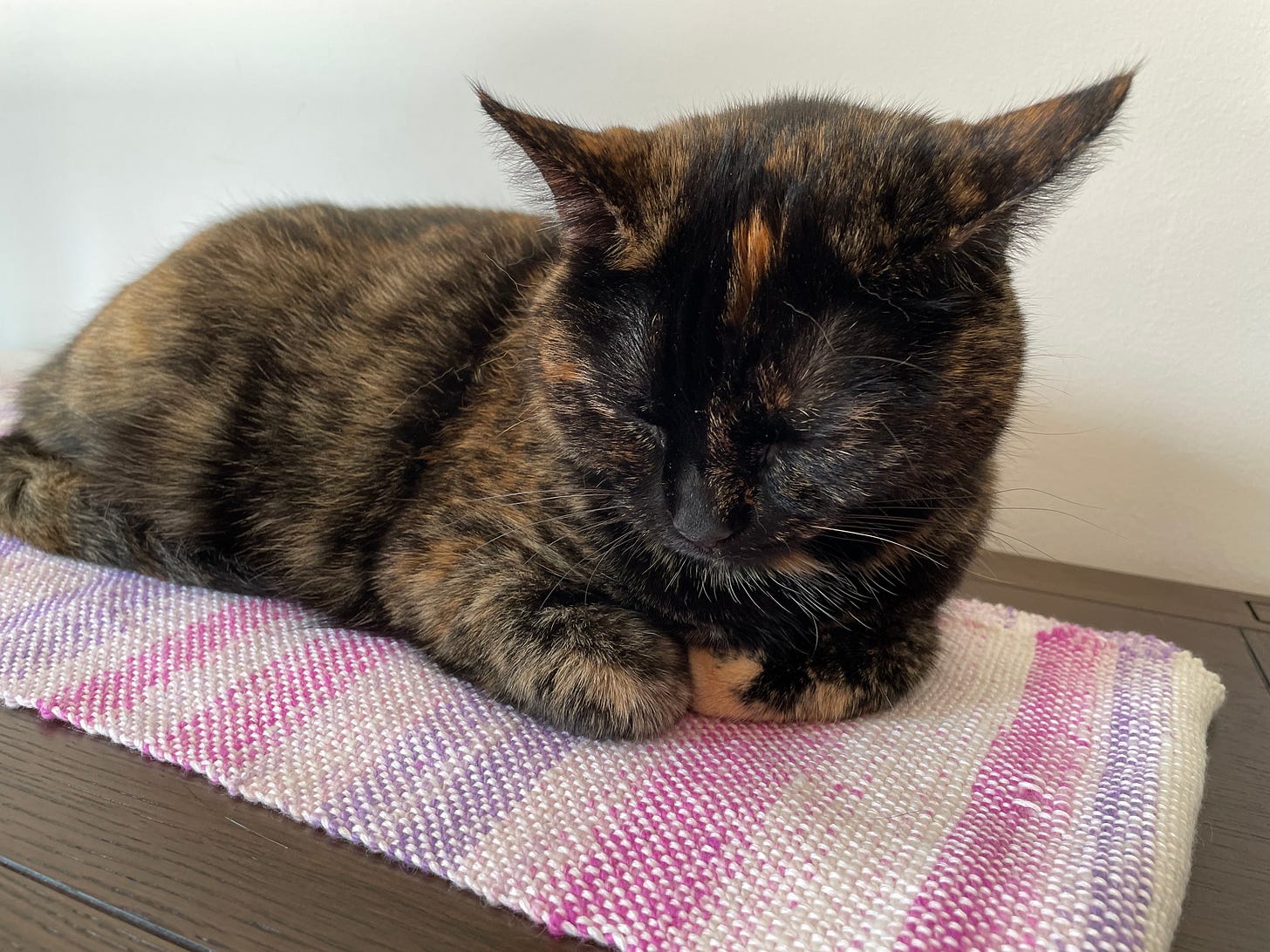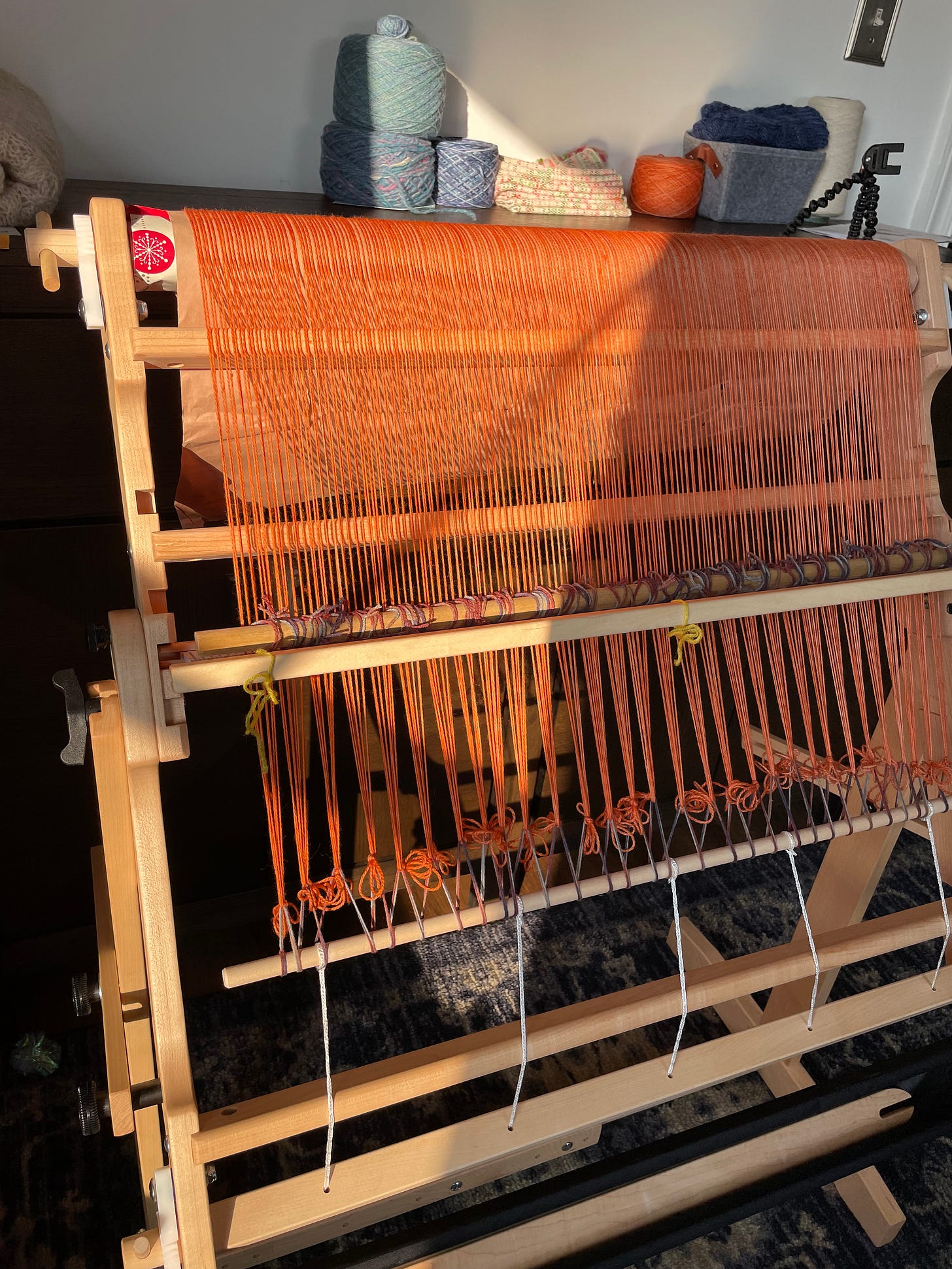Most of my knit night posts will probably happen at times that are not night. Just to warn you.
I’ve mentioned before that I’m learning how to weave.
After the MY LADY JANE TV show got the green light, I ordered a 25” Schatch Flip — a rigid heddle loom — and it arrived on the day photos from the James Webb Space Telescope went public. Hence the loom’s name: Jane Webb.
I immediately warped it. I didn’t measure. I didn’t do math. I just threw some yarn on there and hoped for the best.
The itch to weave didn’t happen overnight. Or, if it did, it happened a long time ago. And I’ve been wanting to learn ever since, so it’s been a persistent itch. For a couple of years, I’ve been watching YouTube videos about weaving — mostly for beginners, mostly for rigid heddle looms. So I did know (basically) what to do when my loom arrived.
Anyway, I made a very long . . . thing. It could be a scarf for a giant. Or it could be a wonky table runner. Or it could be something I fold up and let my cats sit on.
Then I made a scarf for my sister. (Have I shipped it to her yet? No I have not. But it is made!) I made some autumn . . . uh, pieces of fabric. And then I made an oceany shawl for a friend.
Currently, I’m working on another piece of fabric that will look good with cats and books. The warp is white alpaca, and the weft is handspun merino. Then I ran out of the merino and decided to put on something else for the rest of the warp . . . and that’s where things went wrong.
Quick explainer about how weaving works, for anyone who’s confused about the weaving vocabulary:
Warp is both a noun and a verb. Warp is the vertical threads. These have to be really strong and hold up under a lot of tension. (Less tension on a rigid heddle loom, like I have. More tension on a floor or table loom. Which I don’t have.)
The warp gets measured out, then rolled onto the back beam with paper separators between the layers. (I’ve used brown paper from a box of author copies . . . and holiday wrapping paper. You use what you have.)
The tension needs to be consistent across the whole width of the loom, so it’s a bit fiddly to get even. At least for me, a beginner. Then the warp gets threaded through the heddle, tied on to the front, and you can start weaving.
You weave with the weft yarn. (For a long time, I remembered the difference as weaving left — rhymes with weft — and right.) This yarn doesn’t have to be as strong, because it’s not under the same tension. But obviously it shouldn’t fall apart either. Use reason!
When you’ve woven up as far as you comfortably can, you advance the warp: you roll it onto the front/cloth beam, off the back beam, using the gears and brakes on the sides of the loom.
Okay. That’s basically it.
So here’s where things went wrong for me.
You can probably tell here that the weaving has gotten significantly narrower toward the top. That’s not supposed to happen.
I have a few ideas about what I did, and they all have to do with tension and the way I was packing the weft yarn on. My mistakes.
Generally, I’m the kind of knitter (and writer) who’d rather just rip something out and start over again, but un-weaving is different from ripping out knitting or crochet. I’ve done small amounts before, but this one looked extra annoying to do. Just look at how tightly it’s packed! So I dithered for a bit. Asked Instagram. Asked my husband. Eventually, I decided to try un-weaving it and use the red yarn for something else in the future.
That . . . didn’t work. It’s all felted together. You can even see in the photo how the white fibers are poking through the red, making it look fuzzy, rather than smooth. It’s packed in there so well that un-weaving would rip apart some of the individual fibers. It would weaken the warp yarn to the point it wouldn’t hold up under tension anymore. And dealing with all this would kill my joy in this project.
So I cut the yarn and started hemstitching the top. (The bottom is hemstitched — that’s why it looks like little groups of three warp threads. This holds the end weft threads in so they don’t slip out when you remove the piece from the loom.)
I’m not adding to the red. And I’m not taking it out. It’s a learning experience. I’ll save the rest of that yarn for something else.
There’s more warp on the loom, so I’ll move on and try something else. Hopefully it’ll work better. And if it doesn’t, well, I’m still learning. I can cut myself some slack. Just not the loom. (Haha. Get it? Because the weaving needs tension? Okay I’m going home.)
In other yarn news, I finished the Wingspan I was knitting for my agent. I spun singles for a three-ply yarn (that needs to be plied). And I knit myself a hat.
The fiber festival that was supposed to happen last weekend didn’t happen, thanks to Hurricane Ian’s leftovers. But don’t worry. I’m still going to get some nice yarn stuff for myself.
Happy almost weekend!







